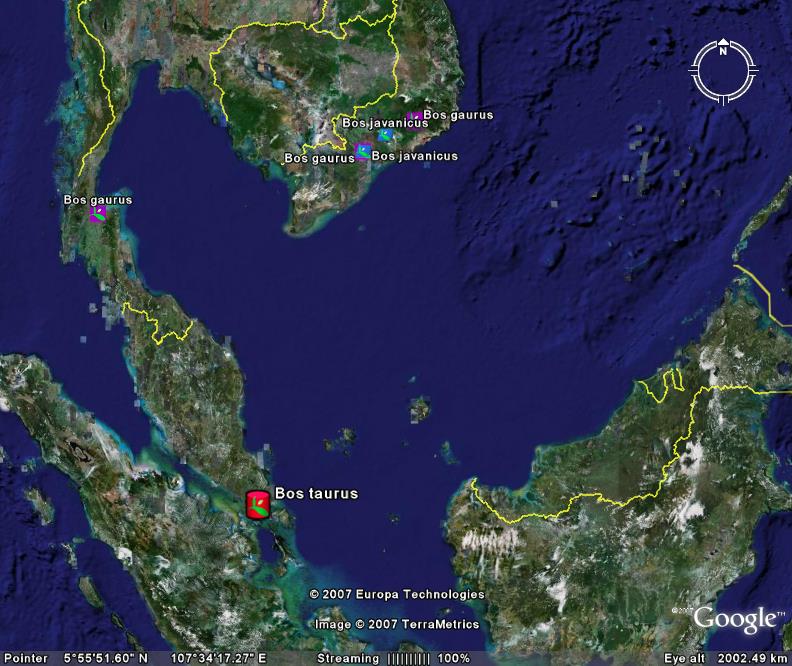Proteins found in buckwheat ((Fagopyrum esculentum, a pseudo-cereal of Himalayan origin)) grain seem to cut down the absorption of cholesterol, at least in vitro, according to a recent study. Is there genetic variation in this property? Well, I don’t suppose anyone has looked yet, but a paper just out in GRACE does point to significant variation in protein profiles among varieties and species.
Mapping wild bovids
Michael’s post on the kouprey made me realize how ignorant I am on the subject of wild bovids. That, and news of the launch of the new GBIF portal, prompted some online fun and games last night.

I’ll just give you the edited highlights here. But I guarantee that playing with the GBIF data portal will keep you busy — and entertained — for hours.
I searched for all Bos spp specimens that GBIF has occurrence data for, then downloaded the resulting kml file and opened it in Google Earth. The map above is just a view of the records for SE Asia. Not that many, and none for the kouprey. Bos javanicus is the banteng. The records in southern Vietnam refer to specimens (stuffed, presumably, or maybe just skins, I’m not sure) from the Field Museum in Chicago.
I got quite excited when I saw the name of the collector. One T. Roosevelt. But it was not to be. This T. Roosevelt collected (shot?) the banteng specimen now in the Field Museum in 1929, which is ten years after the first President Roosevelt died.
I also did similar things for a couple of crop wild relatives, but I’ll keep that for another time. Remember, one of the data providers to GBIF is SINGER, to the tune of over half a million records of germplasm accessions of crops and wild crop relatives.
Later that day: So GBIF has a thing where you can send feedback on individual records, so I did that for T. Roosevelt’s banteng and within a few hours I had a email back from Larry Heaney at the Field Museum. It turns out that we’re dealing here with Teddy Jr, the president’s son, who spent a lot of time on expeditions in Asia. Larry says that there are also some specimens around collected by Teddy Jr’s brother, Kermit. Thanks, Larry. I don’t know quite why, but this whole story made my day.
Is the kouprey a species?
The kouprey is a very elusive wild bovid that is said to roam the Southeast Asian jungle. It was only discovered by outsiders at the beginning of the last century, but it has seldom been seen since and there are concerns that it may, in fact, already be extinct. (It is currently listed on the IUCN Red List of Endangered Species). As if that wasn’t bad enough, there is now a vigorous debate about whether the kouprey is — or was — in fact, a separate species at all, or merely some type of feral hybrid.
A report published some months ago in the Journal of Zoology showed that a comparison of mitochondrial DNA obtained from several banteng revealed some homology — similarity — with a previously published DNA sequence from a kouprey. ((Galbreath et al., 2006. J. Zool. 270:561)) The banteng is another bovid that has to some degree been domesticated, but can also still be found in the wild in several Southeast Asian countries. Based on their analysis, the authors concluded that the kouprey is more than likely just a hybrid originating from crosses between zebu cattle and the banteng. Now, some might argue that it is pretty bold to reach such a profound conclusion based on a very small sample size, and not surprisingly some have indeed so argued. They have pointed out that anatomical and even DNA evidence from their own studies did not support stripping the kouprey of its species status. ((Grigson, 2007. J Zool. 271:239; Hassanin and Robiquet, 2007. J. Zool. 271:246)) An alternative explanation might simply be that there has been introgression of DNA from one species into the other by occasional matings. And there is ample evidence that this has happened in other species. Cattle DNA is commonly found in the American bison, for example, because of past attempts by cattle breeders to generate what they thought would be more viable bison-cattle hybrids. ((Rasmussen et al., 2005. Mol. Reprod. Dev. 70:228))
What is clearly needed to settle the matter is additional analysis of nuclear DNA obtained from more than one kouprey. But if the animal has, indeed, already disappeared, that may prove to be difficult. ((Contributed by Michael Kubisch))
Cassava genes flow
Cassava exchanges precious bodily fluids with wild relative in French Guiana.
IITA cores its yams
A core collection has been identified for West African yams.